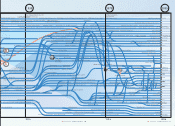Toshiba 2005 Annual Report Download - page 21
Download and view the complete annual report
Please find page 21 of the 2005 Toshiba annual report below. You can navigate through the pages in the report by either clicking on the pages listed below, or by using the keyword search tool below to find specific information within the annual report.
130th Anniversary Toshiba Corporation 21
Mobile Broadcasting Receiver
A receiver dedicated exclusively to receiving mobile
broadcasts has been developed to support the com-
mercial launch of “MobaHO!” Operated by Mobile
Broadcasting Corporation, this is the world’s first multi-
channel satellite digital broadcasting service geared
toward individuals using mobile equipment. The receiv-
er is light and compact, weighing in at approximately
320 grams, thanks to an LSI developed expressly for
mobile broadcasting and incorporation of the antenna
into the body of the unit.
Perpendicular Magnetic Recording Hard Disk Drive
By bringing perpendicular data recording to magnetic
disk data storage, Toshiba has enhanced both HDD
recording density and data storage stability. A real
recording density of 206 megabits per mm2is the highest
level yet reported, and was achieved with newly developed
magnetic materials in the disk’s recording layer. Toshiba
expects to be first to commercialize* a perpendicular
HDD in 2005.
* as of December 14, 2004
Ubiquitous Viewer
An achievement of R&D efforts during fiscal 2004,
this world-first breakthrough allows remote access
and use of all software installed on a PC via a mobile
phone. On-screen information from the PC is received
as a compressed image, a less data hungry approach
that speeds communication. Operation goes beyond
browsing to include editing, and changes can be
made and results seen and checked by simple
button operations.
Digital Products Segment enjoyed a fruitful year.
Operating income improved significantly in the PC
business, which made marked progress in overcoming
recent challenges. Mobile Phone business and Digital
Media & Network business brought the guiding
concept of “Imaging by Toshiba” to tangible form
by developing products that achieved competitive
advantage by drawing on the collective strength of
Toshiba Group.
Segment sales rose by a robust ¥214.8 billion com-
pared to a year earlier, and operating income and
loss showed a notable improvement of ¥31.1 billion
against the previous term.
Mobile Communications Company
Results for the term under review: Sales revenue matched
the previous year’s, while operating income grew on
continuous launches of new models that emphasized
high performance and design excellence. In the domestic
market, maintained the largest share among Japan’s
NCCs (New Common Carriers): KDDI Corporation,
Vodafone K.K., and TU-KA Cellular Tokyo Inc. In fiscal
year 2005, continued reinforcement of the domestic base
will be complemented by moves, which are expected to
bolster performance, to a stronger presence in Europe
and the global market.
Challenges and strategies: It is pivotal to continue devel-
oping useful, fun to use multimedia Mobile Phones that
integrate the highly advanced technologies in which the
business excels, including Bluetooth™, MPEG4 image-
processing LSI, SD memory cards, Low Temperature
Polysilicon LCDs, CMOS camera modules, and kana to kanji
Japanese text conversion technology. These capabilities
have already won a firm position in the domestic market
for CDMA and PDC terminals. In 3G mobile phones, cell
phones in the two major formats, W-CDMA and
cdma2001X/EV-DO, have already been commercialized.
Toshiba is highly proactive on the transition to 3G, a
trend now gaining momentum worldwide, and views the
shift as a promising opportunity to expand business.
























